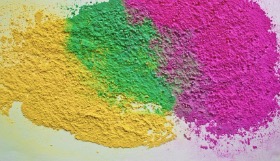The role of pigments and fillers in paint
Coatings, traditionally known as paints in China, are generally composed of four basic components: film-forming substances (resins, emulsions), pigments (including extenders), solvents and additives (auxiliaries). Pigments are divided into two types: one is coloring pigments, such as titanium dioxide, chrome yellow, etc., and the other is extender pigments, such as calcium carbonate, talc.

Pigment (filler), referred to as pigment, is an important part of paint, but it cannot form a film alone, so it is also called a secondary film-forming substance. Pigments are generally fine powdery colored substances, which are uniformly dispersed in the film-forming substances and their solutions through stirring, grinding, and high-speed dispersion in the coating production process to form colored paints. After the coating film is formed, the pigment is uniformly dispersed in the coating film, and the essence of the coating film is the solid co-dispersed composite of the pigment and the film-forming polymer.


Commonly used coloring pigments are titanium dioxide, strontium yellow, phthalocyanine blue, toluidine red, graphite, carbon black, china blue, ultramarine, etc.; commonly used volume pigments (also known as fillers) are calcium carbonate, calcium phosphate, mica, barium sulfate , talc, diatomaceous earth, etc., volume pigments are often used to adjust the pigment volume concentration (Pvc) of coatings to enhance the mechanical strength and adhesion of paint films, and to adjust the penetration and gloss of water, gas and corrosive media. Volume pigments are generally cheaper, so after the amount of coloring pigments in the coating formulation is determined, the remaining amount of Pvc is filled with volume pigments, so volume pigments are also called fillers.

Functional pigments are pigments with characteristic functions, such as anti-rust pigments, anti-fouling pigments, flame-retardant pigments, conductive pigments, etc. The price of functional pigments is high, so the dosage is to meet the functional requirements.














